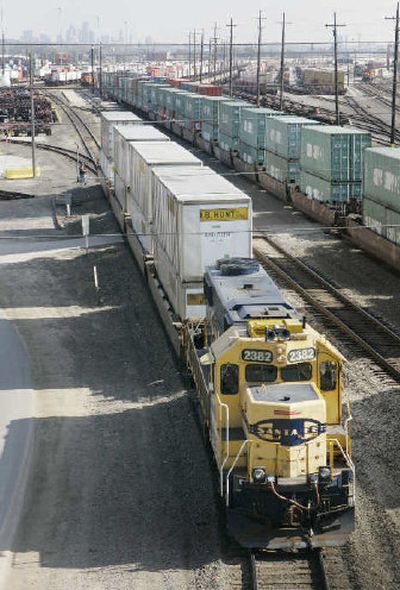Clearing the rails

FORT SUMNER, N.M. – Perched at a big window in the last rail car, Matthew Rose watched as he passed three westbound trains near the Pecos River Bridge, then four eastbound trains on the other side of the span.
None were moving. Some would not budge for at least a half-hour, as they waited their turn to cross the short bridge over a dry riverbed.
“When you think of bottlenecks, this is the best example we could possibly give you,” said Rose, chairman and chief executive of Burlington Northern Santa Fe Corp., on whose tracks the trains were stalled.
The backup on this stretch of track near the Texas state line is as predictable as the sun coming up in the morning over the parched plains. It’s one of a handful of spots on Burlington Northern’s main Los Angeles-Chicago route that narrows to a single track.
The company plans to complete a second 1,500-foot bridge across Pecos River in 2008, at a cost of $30 million, as part of a years-long campaign to increase capacity on the transcontinental route.
“If we had that bridge today, we’d be flowing,” Rose said.
After a quarter-century of decline, freight railroads are enjoying a revival as a rising economy and a surge of imports from China has meant more goods than ever riding on the rails. Shippers, however, aren’t sharing in the joy — the boom in rail traffic means bottlenecks, declining service and longer delays getting their goods to market.
The reasons for the railroads’ turnaround are varied. Demand for coal helps, as does a pickup in agricultural shipments. And truckers that compete with rail have raised their prices and face a shortage of drivers that has slowed service.
But clearly one of the biggest factors is the boom in imports from China and other Asian countries. Those goods, from clothing to furniture, come into West Coast ports and are delivered by rail or truck to factories and stores across the country. Shipping containers for Yang Ming, Cosco and Hyundai are common sights on trains leaving West Coast ports.
The import boom has put more pressure on Burlington Northern to improve its major Los Angeles-Chicago route and on Union Pacific Corp. to expand its line from L.A. to El Paso, Texas, where it connects with tracks heading farther east.
That is how Burlington CEO Rose found himself on a train last week, surveying the backup in a remote section of New Mexico.
Burlington Northern expects imports to help push traffic on transcontinental rail lines up 6 percent to 10 percent a year. The company has several ideas for handling the extra load.
The railroad plans to use longer trains, up to nearly two miles long. It is testing automated systems that put trains closer together while still providing safe braking distance, which it believes could raise capacity 15 percent to 20 percent. Union Pacific plans to test similar technology around Spokane.
The railroads are also adding track, at a cost of up to $3 million a mile, not counting bridges or tunnels. Union Pacific will convert half its Los Angeles-to-El Paso, Texas, line to double track by the end of this year, and Burlington Northern says it will finish double-tracking from L.A. to Chicago by the end of 2008.
Getting rid of a single-track bottleneck like the one at Pecos River Bridge can boost capacity in that segment 50 percent, from 80 trains a day to 120, according to Chris Roberts, a regional vice president for Fort Worth, Texas-based Burlington Northern.
Burlington Northern plans to spend $400 million this year on expansion, not counting buying 320 locomotives, which will push its fleet above 5,000.